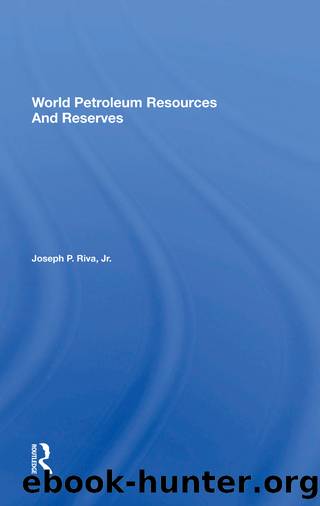World Petroleum Resources and Reserves by Joseph P. Riva

Author:Joseph P. Riva [Riva, Joseph P.]
Language: eng
Format: epub
Tags: Science, Environmental Science, Nature, Environmental Conservation & Protection
ISBN: 9780865314467
Google: Gz-4AAAAIAAJ
Goodreads: 2515982
Publisher: Westview Press
Published: 1983-04-25T00:00:00+00:00
Production, Reserves, and Resources
The petroleum history of Alaska for the past decade is shown in Table 7.1.*15 The very large increase in reserve additions in 1970 represents, primarily, the Prudhoe Bay reserves. Although discovered in 1968, the reserves were not proved (by additional drilling) and added to Alaskan reserve estimates until 1970. With oil reserves in Prudhoe Bay estimated at 9,400 million barrels, it is evident from the table that Prudhoe Bay dominates Alaskan oil. Over 88 percent of the oil discovered in the state in the past decade was in this single super-giant field. The significant production increases that began in 1977 are the result of the completion of the trans-Alaska crude-oil pipeline, which allowed production to begin from the Prudhoe Bay field. Prudhoe Bay accounts for over 90 percent of Alaska's oil production, which was 591 million barrels in 1980 from a reserve of 8,799 million barrels. Inferred oil reserves in Alaska are estimated to be 5,000 million barrels.16
The undiscovered recoverable oil resources in Alaska have recently been estimated by the U.S. Geological Survey.17 These modified estimates are shown in Table 7.2. For the state as a whole, the Geological Survey has calculated the range of undiscovered recoverable conventional oil onshore as 2,500 (95 percent probability) to 14,600 (5 percent probability) million barrels and offshore as 4,600 (95 percent probability) to 24,200 (5 percent probability) million barrels. High and low probability estimates are not additive.
Table 7.2 indicates that the expected amount of oil yet to be discovered in Alaska is about 19.2 billion barrels (12.3 billion offshore and 6.9 billion onshore). This amounts to only two more Prudhoe Bays. The distribution of the undiscovered oil is of importance. A 70-million-barrel field (Umiat) has been discovered on the North Slope but is shut in because it is not yet commercially viable, indicating that an onshore field would have to have reserves of at least 100 million barrels (or more, depending upon location) to be developed. Offshore, this amount may be expected to be at least doubled for a field to be commercially viable, particularly in areas of Arctic pack ice. This would indicate that some basins may have few, if any, commercial fields. As giant fields are usually not numerous in any basin, development in Alaska's offshore areas will not be intense. Development activity cannot be expected to even approach that in the Gulf of Mexico, where several thousand offshore platforms have been constructed.
Prudhoe Bay will begin its decline in the mid-1980s and will be producing less than 1 million barrels per day in the early 1990s. Because of long lead times, replacement of this lost oil production will have to come from other North Slope prospects now being developed. It is possible, but not assured, that North Slope oil production can be held at current levels during the latter part of the 1980s, but production in the 1990s depends upon exploration success in the frontier areas, particularly offshore. This will require additional federal leasing and the commercialization of the technology necessary to develop oil fields under Arctic pack ice.
Download
This site does not store any files on its server. We only index and link to content provided by other sites. Please contact the content providers to delete copyright contents if any and email us, we'll remove relevant links or contents immediately.
| Coatings, Ceramics & Glass | Cosmetics |
| Fluid Dynamics | Plant Design |
| Plastics | Unit Operations & Transport Phenomena |
Whiskies Galore by Ian Buxton(41888)
Introduction to Aircraft Design (Cambridge Aerospace Series) by John P. Fielding(33064)
Small Unmanned Fixed-wing Aircraft Design by Andrew J. Keane Andras Sobester James P. Scanlan & András Sóbester & James P. Scanlan(32744)
Craft Beer for the Homebrewer by Michael Agnew(18146)
Turbulence by E. J. Noyes(7943)
The Complete Stick Figure Physics Tutorials by Allen Sarah(7312)
Kaplan MCAT General Chemistry Review by Kaplan(6868)
The Thirst by Nesbo Jo(6834)
Bad Blood by John Carreyrou(6559)
Modelling of Convective Heat and Mass Transfer in Rotating Flows by Igor V. Shevchuk(6392)
Learning SQL by Alan Beaulieu(6214)
Weapons of Math Destruction by Cathy O'Neil(6152)
Man-made Catastrophes and Risk Information Concealment by Dmitry Chernov & Didier Sornette(5926)
Digital Minimalism by Cal Newport;(5670)
Life 3.0: Being Human in the Age of Artificial Intelligence by Tegmark Max(5479)
iGen by Jean M. Twenge(5368)
Secrets of Antigravity Propulsion: Tesla, UFOs, and Classified Aerospace Technology by Ph.D. Paul A. Laviolette(5311)
Design of Trajectory Optimization Approach for Space Maneuver Vehicle Skip Entry Problems by Runqi Chai & Al Savvaris & Antonios Tsourdos & Senchun Chai(5012)
Pale Blue Dot by Carl Sagan(4917)
